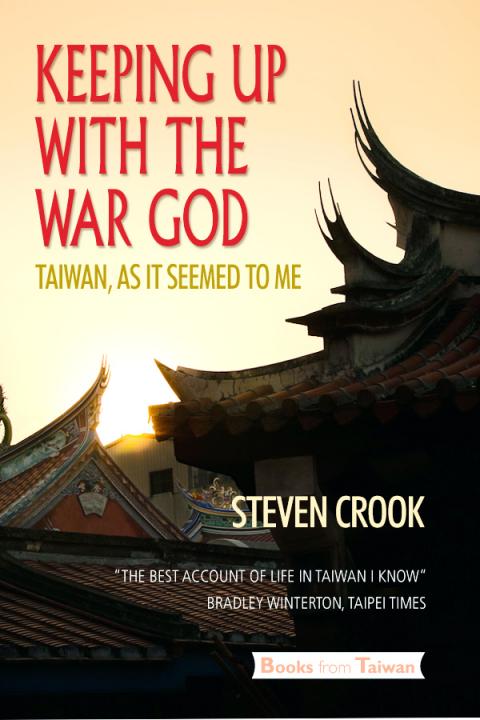Search Amazon.com for “Taiwan” and you will find almost nothing other than guidebooks, academic histories and political studies.
“It’s a tragedy that so few books have been written about Taiwan,” says New Zealander expatriate John Ross, author of Formosan Odyssey (reviewed in the Taipei Times on July 7, 2002). “The country has such an interesting history, geography, political situation, and culture … You could spend a lifetime writing about Taiwan and not run out of material.”
To remedy what he sees a dearth of literature, Ross has organized an English-language book festival, which takes place this weekend at Alleycat’s Pizza in Taipei’s Huashan 1914 Creative Park (華山1914).

Photo Courtesy Steven Crook
The aim is to “provide a place where authors and readers can sell and buy books and, hopefully, encourage more foreign residents to write about Taiwan,” Ross says.
Presentations and group discussions will be led by established authors in Taiwan, such as Jerome Keating (Islands in the Stream: A Quick Case Study of Taiwan’s Complex History and Taiwan: The Search for Identity), Syd Goldsmith (Jade Phoenix), and Steven Crook (Taiwan: The Bradt Travel Guide, Do’s and Don’ts in Taiwan and Keeping Up With the War God).
The focus of the presentations will not be on how to get work picked up by publishing houses, but on self-publishing. “Other than textbooks, the market for English-language books is very small,” Ross says. “Self-publishing, however, is becoming easier, and Taiwan is a great place to do it.”
Several of the festival’s featured authors have self-published books. Other speakers include prominent bloggers, such as Carrie Kellenberger (freelance writer and editor and owner of www.MySeveralWorlds.com, currently one of the most successful travel blogs in the world), Craig Ferguson (professional photographer and blogger at www.CraigFergusonImages.com), and David Reid (freelance writer and blogger at www.blog.taiwan-guide.org). There will be discussions on citizen journalism and how to make money by writing online.
Though this is the festival’s first edition, Ross has high hopes. In the future, he aims “to broaden the focus of the festival to include Taiwanese book lovers, get publishers involved, and invite some foreign guest authors to Taiwan for the event.”

Most heroes are remembered for the battles they fought. Taiwan’s Black Bat Squadron is remembered for flying into Chinese airspace 838 times between 1953 and 1967, and for the 148 men whose sacrifice bought the intelligence that kept Taiwan secure. Two-thirds of the squadron died carrying out missions most people wouldn’t learn about for another 40 years. The squadron lost 15 aircraft and 148 crew members over those 14 years, making it the deadliest unit in Taiwan’s military history by casualty rate. They flew at night, often at low altitudes, straight into some of the most heavily defended airspace in Asia.

Beijing’s ironic, abusive tantrums aimed at Japan since Japanese Prime Minister Sanae Takaichi publicly stated that a Taiwan contingency would be an existential crisis for Japan, have revealed for all the world to see that the People’s Republic of China (PRC) lusts after Okinawa. We all owe Takaichi a debt of thanks for getting the PRC to make that public. The PRC and its netizens, taking their cue from the Chinese Communist Party (CCP), are presenting Okinawa by mirroring the claims about Taiwan. Official PRC propaganda organs began to wax lyrical about Okinawa’s “unsettled status” beginning last month. A Global

Taiwan’s democracy is at risk. Be very alarmed. This is not a drill. The current constitutional crisis progressed slowly, then suddenly. Political tensions, partisan hostility and emotions are all running high right when cool heads and calm negotiation are most needed. Oxford defines brinkmanship as: “The art or practice of pursuing a dangerous policy to the limits of safety before stopping, especially in politics.” It says the term comes from a quote from a 1956 Cold War interview with then-American Secretary of State John Foster Dulles, when he said: ‘The ability to get to the verge without getting into the war is

Like much in the world today, theater has experienced major disruptions over the six years since COVID-19. The pandemic, the war in Ukraine and social media have created a new normal of geopolitical and information uncertainty, and the performing arts are not immune to these effects. “Ten years ago people wanted to come to the theater to engage with important issues, but now the Internet allows them to engage with those issues powerfully and immediately,” said Faith Tan, programming director of the Esplanade in Singapore, speaking last week in Japan. “One reaction to unpredictability has been a renewed emphasis on